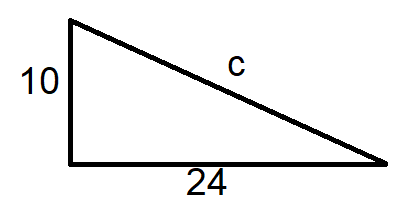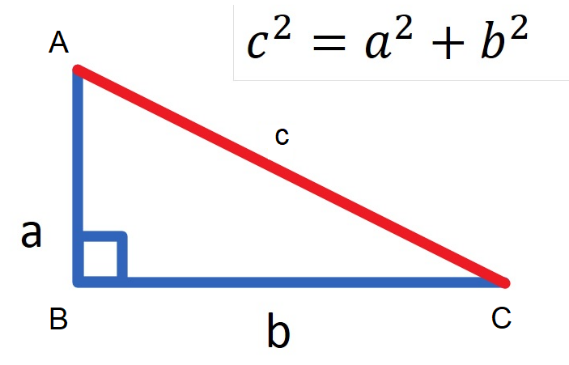
What is the value of $c$?


Answer
513.3k+ views
Hint: We first describe the Pythagorean identity with respect to the right-angle triangle. We use the formula of ${{\left( base \right)}^{2}}+{{\left( height \right)}^{2}}={{\left( hypotenuse \right)}^{2}}$. Putting the values, we get ${{10}^{2}}+{{24}^{2}}={{c}^{2}}$. We solve to find the value of $c$.
Complete step by step solution:
The Pythagorean identity is about the trigonometric identity that is used in case of right-angle triangles.
The Pythagorean trigonometric identity, also called simply the Pythagorean identity, is an identity expressing the Pythagorean theorem in terms of trigonometric functions. Along with the sum-of-angles formulae, it is one of the basic relations between the sine and cosine functions.
We express it for $\Delta ABC$ where $\angle B=\dfrac{\pi }{2}$.

We have the expression for the triangle as ${{\left( base \right)}^{2}}+{{\left( height \right)}^{2}}={{\left( hypotenuse \right)}^{2}}$.
For $\Delta ABC$, $base=BC=b,height=AB=a,hypotenuse=AC=c$
Applying the rule, we get ${{\left( a \right)}^{2}}+{{\left( b \right)}^{2}}={{\left( c \right)}^{2}}$.
We can also express it with respect to the angle $\angle BCA$. Let $\angle BCA=\theta $.
The equation ${{\left( a \right)}^{2}}+{{\left( b \right)}^{2}}={{\left( c \right)}^{2}}$ can be simplified
$\begin{align}
& {{a}^{2}}+{{b}^{2}}={{c}^{2}} \\
& \Rightarrow {{\left( \dfrac{a}{c} \right)}^{2}}+{{\left( \dfrac{b}{c} \right)}^{2}}=1 \\
\end{align}$
With respect to the angle $\angle BCA=\theta $, we have $\dfrac{a}{c}=\sin \theta ,\dfrac{b}{c}=\cos \theta $.
Replacing the values, we get ${{\sin }^{2}}\theta +{{\cos }^{2}}\theta =1$.
There are many reformed versions of the formula ${{\sin }^{2}}\theta +{{\cos }^{2}}\theta =1$.
Dividing with ${{\cos }^{2}}\theta $, we got \[{{\tan }^{2}}\theta +1={{\sec }^{2}}\theta \].
Dividing with ${{\sin }^{2}}\theta $, we got \[{{\cot }^{2}}\theta +1={{\csc }^{2}}\theta \].
For the given image we have 10 as height and 24 as base.
Therefore, ${{c}^{2}}={{10}^{2}}+{{24}^{2}}=100+576=676$.
Taking square root, we get $c=\sqrt{676}=26$.
We have the length of the hypotenuse as 26 units.
Note: The concept of Pythagorean identity is similar for both angles and sides. The representation of the triangle has to be for the right-angle triangle.
The figure shows how the sign of the sine function varies as the angle changes quadrant.
Complete step by step solution:
The Pythagorean identity is about the trigonometric identity that is used in case of right-angle triangles.
The Pythagorean trigonometric identity, also called simply the Pythagorean identity, is an identity expressing the Pythagorean theorem in terms of trigonometric functions. Along with the sum-of-angles formulae, it is one of the basic relations between the sine and cosine functions.
We express it for $\Delta ABC$ where $\angle B=\dfrac{\pi }{2}$.

We have the expression for the triangle as ${{\left( base \right)}^{2}}+{{\left( height \right)}^{2}}={{\left( hypotenuse \right)}^{2}}$.
For $\Delta ABC$, $base=BC=b,height=AB=a,hypotenuse=AC=c$
Applying the rule, we get ${{\left( a \right)}^{2}}+{{\left( b \right)}^{2}}={{\left( c \right)}^{2}}$.
We can also express it with respect to the angle $\angle BCA$. Let $\angle BCA=\theta $.
The equation ${{\left( a \right)}^{2}}+{{\left( b \right)}^{2}}={{\left( c \right)}^{2}}$ can be simplified
$\begin{align}
& {{a}^{2}}+{{b}^{2}}={{c}^{2}} \\
& \Rightarrow {{\left( \dfrac{a}{c} \right)}^{2}}+{{\left( \dfrac{b}{c} \right)}^{2}}=1 \\
\end{align}$
With respect to the angle $\angle BCA=\theta $, we have $\dfrac{a}{c}=\sin \theta ,\dfrac{b}{c}=\cos \theta $.
Replacing the values, we get ${{\sin }^{2}}\theta +{{\cos }^{2}}\theta =1$.
There are many reformed versions of the formula ${{\sin }^{2}}\theta +{{\cos }^{2}}\theta =1$.
Dividing with ${{\cos }^{2}}\theta $, we got \[{{\tan }^{2}}\theta +1={{\sec }^{2}}\theta \].
Dividing with ${{\sin }^{2}}\theta $, we got \[{{\cot }^{2}}\theta +1={{\csc }^{2}}\theta \].
For the given image we have 10 as height and 24 as base.
Therefore, ${{c}^{2}}={{10}^{2}}+{{24}^{2}}=100+576=676$.
Taking square root, we get $c=\sqrt{676}=26$.
We have the length of the hypotenuse as 26 units.
Note: The concept of Pythagorean identity is similar for both angles and sides. The representation of the triangle has to be for the right-angle triangle.
The figure shows how the sign of the sine function varies as the angle changes quadrant.
Recently Updated Pages
Two men on either side of the cliff 90m height observe class 10 maths CBSE

What happens to glucose which enters nephron along class 10 biology CBSE

Cutting of the Chinese melon means A The business and class 10 social science CBSE

Write a dialogue with at least ten utterances between class 10 english CBSE

Show an aquatic food chain using the following organisms class 10 biology CBSE

A circle is inscribed in an equilateral triangle and class 10 maths CBSE

Trending doubts
Why is there a time difference of about 5 hours between class 10 social science CBSE

Write a letter to the principal requesting him to grant class 10 english CBSE

What is the median of the first 10 natural numbers class 10 maths CBSE

The Equation xxx + 2 is Satisfied when x is Equal to Class 10 Maths

Which of the following does not have a fundamental class 10 physics CBSE

State and prove converse of BPT Basic Proportionality class 10 maths CBSE




